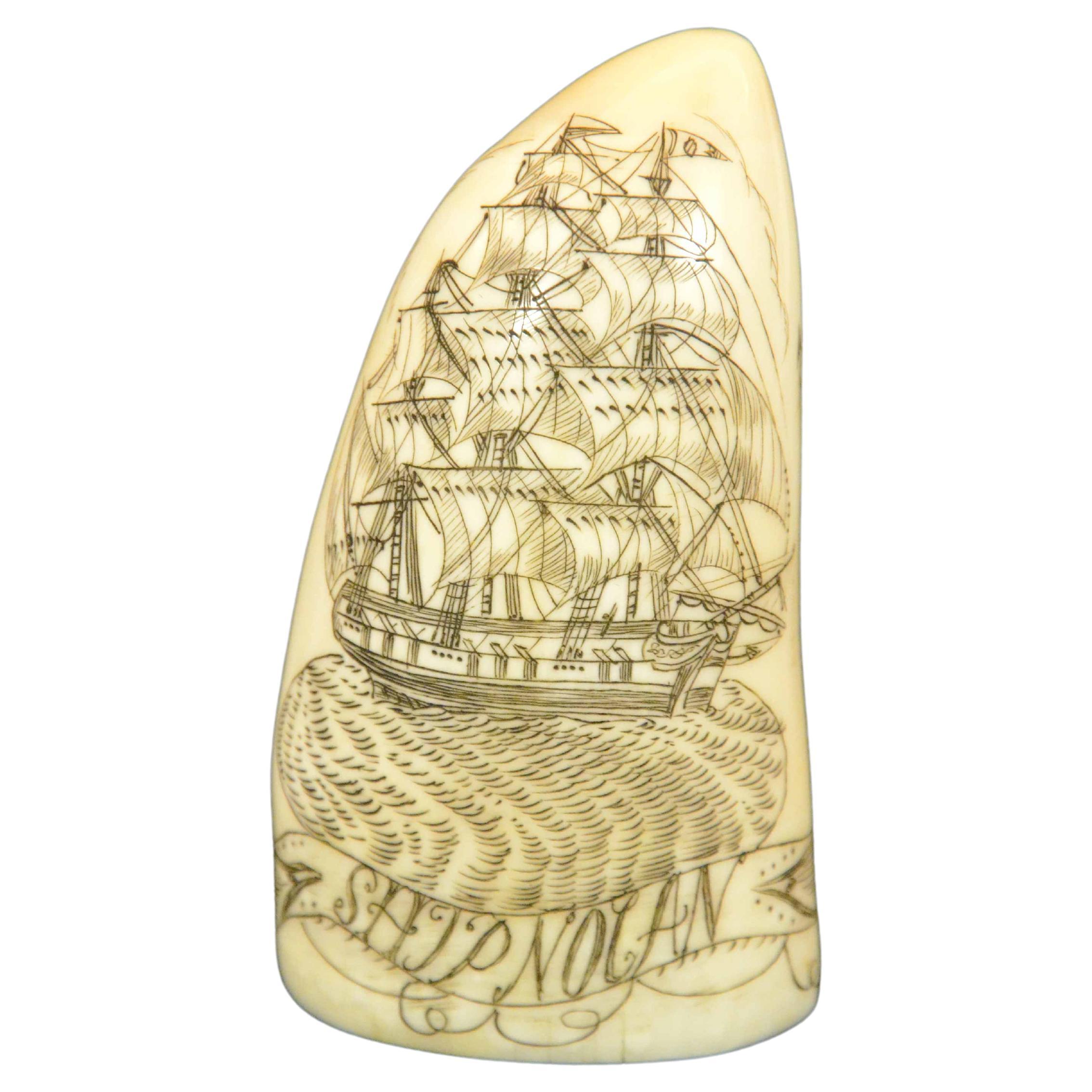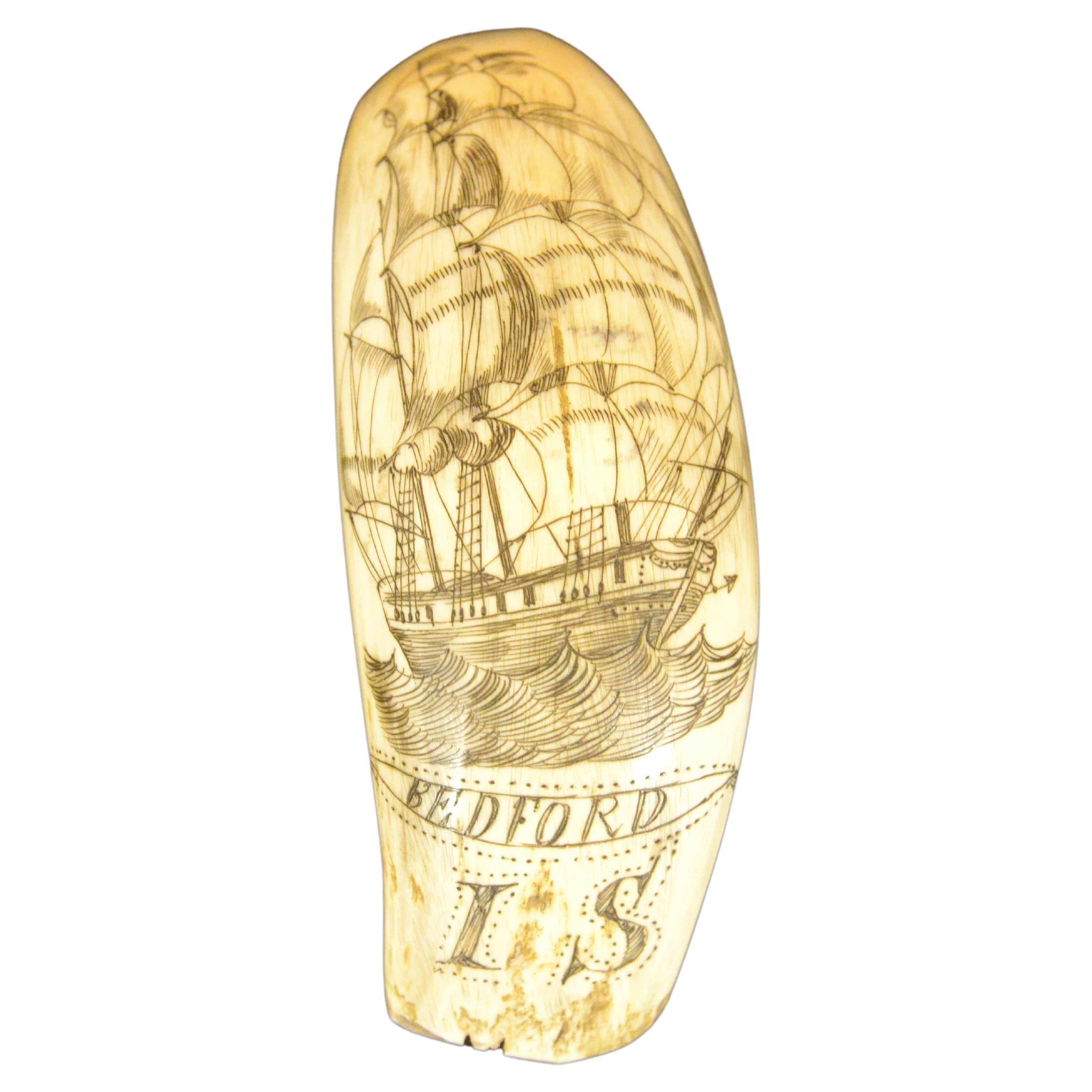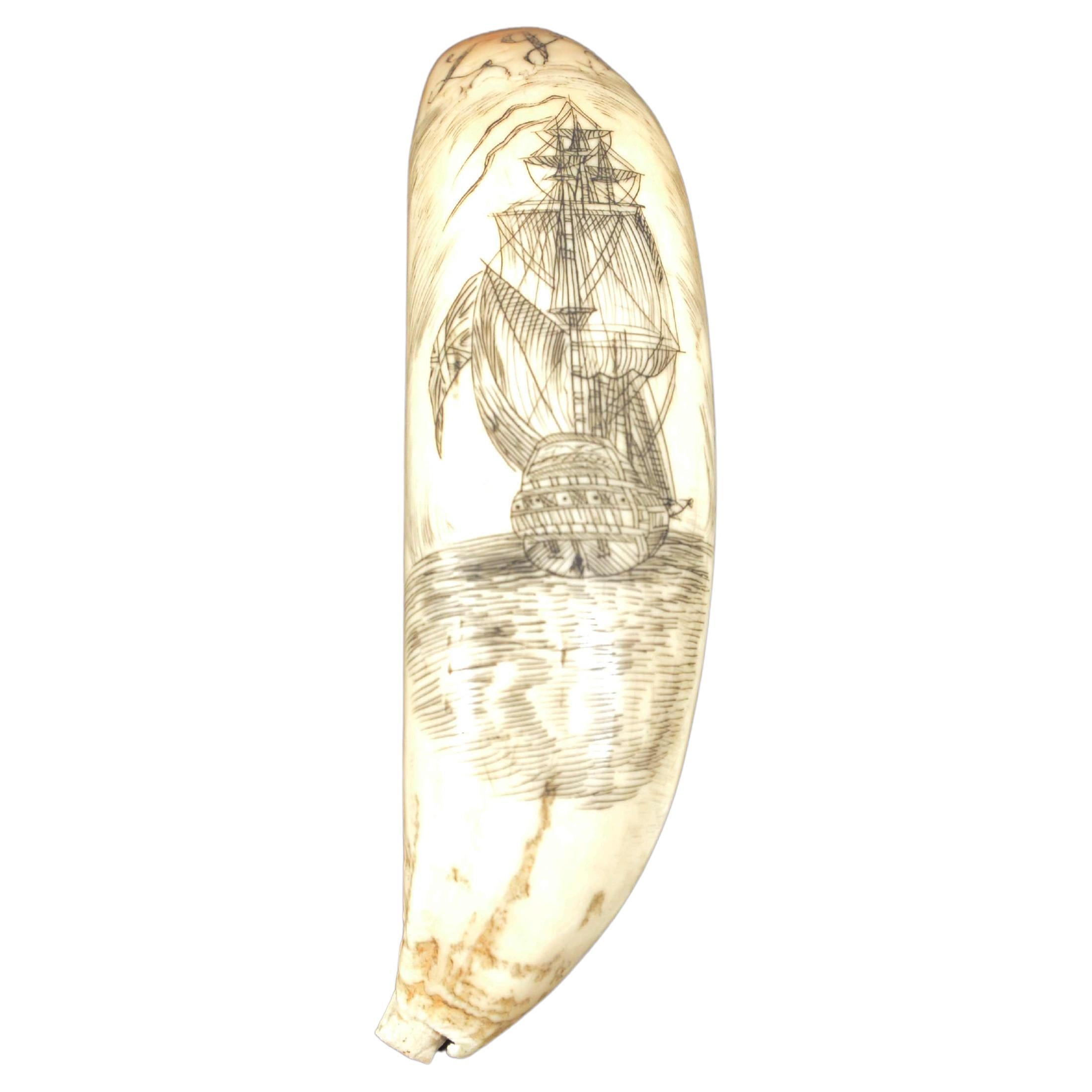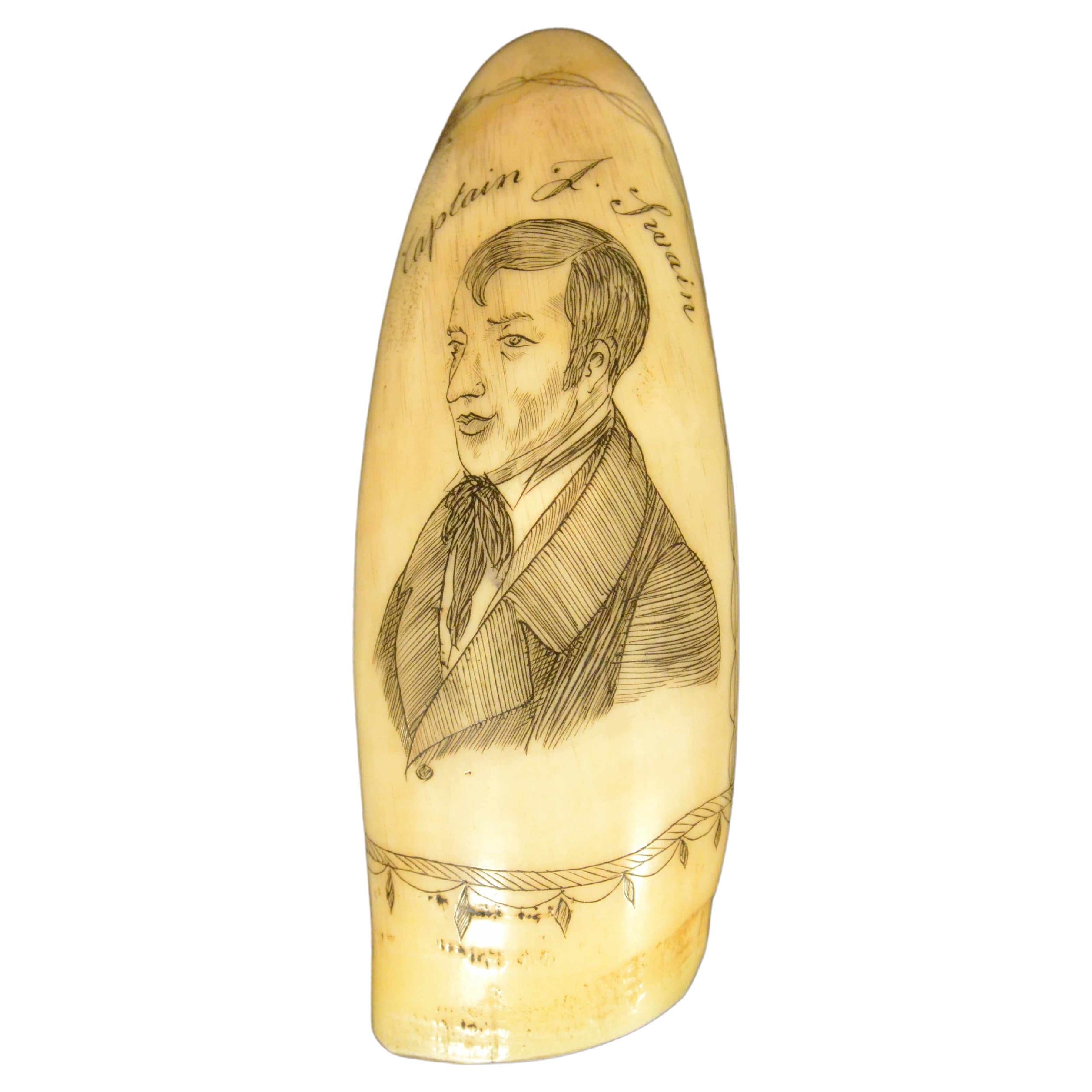Items Similar to Scrimshaw of an engraved whale tooth mid-19th century cm 12, name of the Ship Fox
Want more images or videos?
Request additional images or videos from the seller
1 of 18
Scrimshaw of an engraved whale tooth mid-19th century cm 12, name of the Ship Fox
About the Item
Scrimshaw of an engraved whale tooth, datable to around the mid-19th century, of fine workmanship length cm 12.5, depicting on one side whaling ship with islands and birds in the background, on the side the name of the ship FOX. A large Greek goblet vase is engraved on the back with finely decorated double loop filled with pointed leaves and central flower.
Good condition, small structural crack in the pointed part of the tooth.
Measures 12.5x4x3- inches 4.9x1.6x1.2.
The word "scrimshaw" refers to an art form (and the various products of this art) that developed aboard American whaling ships between 1745 and 1759 as a means of entertainment to occupy time during the long hours aboard; this art form consisted of a process of carving and engraving whale bones and teeth, with which a wide range of both everyday and ornamental objects were made, which were usually made as souvenirs for members of one's family. Nella scelta dei materiali il primo era sicuramente il dente d'avorio del capodoglio. Solo la punta del dente era liscia ed era necessario preparare il resto della superficie ruvida lucidandola. Il dente era ben immerso in acqua salata o calda, spesso con l'aggiunta di potassio. Quindi veniva utilizzata una lima per strofinare e arrotondare la superficie, e infine una carta vetrata fine per completare il processo. L'ultima fase della lucidatura veniva eseguita con pomice o cenere e poi il dente veniva strofinato ancora con il palmo della mano. Each step had to be performed very slowly so as not to affect the smooth surface of the tooth. In terms of subjects for scrimshandering, the most common were a drawing of a ship or scenes of cetacean capture, made with a needle or knife, or an appropriate blade: for example, thanks to Herman Melville we know that some whalers had boxes of dentist's tools specially designed for scrimshandering. The origin of scrimshandering, as the whalers called it, i.e., the art of making scrimshaw, is a mystery: theories range from locating its origin in Eskimo culture or with Native Americans to emphasizing the influence of South Sea islanders. La spiegazione di Edouard A. Stackpole (1903 -1993), giornalista americano, scrittore e storico di caccia alle balene, è forse la più plausibile: lo scrimshaw sarebbe stato semplicemente lo sviluppo marittimo dell'antica arte di intagliare l'avorio, così come era stata praticata per secoli, e in quanto forma d'arte popolare non sarebbe stato altro che un adattamento da parte dei balenieri americani di un antico mestiere.
- Dimensions:Height: 4.9 in (12.45 cm)Diameter: 1.6 in (4.07 cm)
- Materials and Techniques:Teeth
- Period:
- Date of Manufacture:1850
- Condition:Wear consistent with age and use.
- Seller Location:Milan, IT
- Reference Number:1stDibs: LU1020237356702
About the Seller
4.9
Vetted Seller
These experienced sellers undergo a comprehensive evaluation by our team of in-house experts.
Established in 1999
1stDibs seller since 2014
370 sales on 1stDibs
Typical response time: <1 hour
- ShippingRetrieving quote...Ships From: Milan, Italy
- Return PolicyA return for this item may be initiated within 14 days of delivery.
More From This SellerView All
- Scrimshaw of an engraved whale tooth dated 1861 depicting SHIP NOLANLocated in Milan, ITScrimshaw of an engraved whale tooth dated 1861, depicting on one side large sailboat with sails unfurled of excellent workmanship and underneath the name SHIP NOLAN. On the back, a ...Category
Antique 1860s Nautical Objects
MaterialsTeeth
- Scrimshaw of a vertically engraved whale tooth Ship Huron dated 1839 cm 9Located in Milan, ITScrimshaw of a vertically engraved whale tooth, exquisite workmanship dated 1839, height cm 9, depicting whaler near a rock and partially submerged whale, under the name of the ship...Category
Antique 1830s Nautical Objects
MaterialsTeeth
- Scrimshaw of whale tooth engraved front sailing ship on the back the whaler JackLocated in Milan, ITScrimshaw of an engraved whale's tooth, on one side sailing ship with sails unfurled and underneath the name BEDFORD and the initials L S. On the back is the figure of a young whale...Category
Antique Mid-19th Century Nautical Objects
MaterialsTeeth
- Scrimshaw of engraved whale tooth depicting the Captain F. Swain 1850Located in Milan, ITScrimshaw of an engraved whale tooth, depicting on one side the half-bust of the smartly dressed and handsome Captain F. Swain. On the Back the inscription Master The WHALER SWAN f...Category
Antique Mid-19th Century Nautical Objects
MaterialsTeeth
- Scrimshaw of vertically engraved orca tooth depicting vessel mid-19th centuryLocated in Milan, ITScrimshaw of a vertically engraved hour's tooth depicting a vessel bow to left flag of the United Kingdom, above li initials L.G.F. On the back vase with beautiful plant decoration s...Category
Antique Mid-19th Century Nautical Objects
MaterialsTeeth
- Scrimshaw of vertically engraved whale tooth valuable workmanship dated 1882Located in Milan, ITScrimshaw of a vertically engraved whale tooth, of fine workmanship dated 1882, length 12 cm - inches 4.8. The tooth depicts: 6 whalers in rowboat trying to harpoon a whale and whal...Category
Antique 1880s Nautical Objects
MaterialsBone
You May Also Like
- 19th Century Irish Folk Art Whale ToothLocated in Coeur d'Alene, IDIrish Folk Art. This sperm whale tooth was etched during the 19th century, in Ireland. There'sa a drinking sailor on one side, and a barmaid on the other -...Category
Antique Late 19th Century Northern Irish Nautical Objects
MaterialsOther
- Large 19th Century Presentation Half Hull Model of a Whale ShipLocated in Nantucket, MA19th Century Presentation Half Hull Model of a Whale Ship, circa 1850, a large plank on frame model of a bluff-bowed and wide abeam whale ship. The model wa...Category
Antique Mid-19th Century American Folk Art Nautical Objects
MaterialsPine
- 19th Century Diorama of Sailing Ship ‘Eleanor’Located in Dublin 8, IE19th Century diorama of the sailing ship ‘Eleanor’ in original glazed case. Painted antique shadowbox diorama of a three-masthead clipper ship alo...Category
Antique 19th Century Folk Art Models and Miniatures
MaterialsGlass, Wood
- The Valley of Inspruck: An 18th-Century Engraved Perspective, 1792Located in Langweer, NLTitle: "The Valley of Inspruck: An 18th-Century Engraved Perspective" This elegant original antique engraving, titled "The Valley of Inspruck," showcases a serene view of the Innsbruck Valley. The artwork is delicately rendered, capturing the grandeur of the mountains and the pastoral tranquility of the valley. The print depicts a detailed landscape scene, replete with towering craggy peaks that loom over a peaceful settlement nestled in the valley. A striking feature is the contrast between the ruggedness of the natural environment and the cultivated lands and architecture, indicating a harmonious coexistence of humanity with nature. It was published as directed on January 1, 1792, by T & G Egerton of Whitehall for the author. Albanis Beaumont is credited with the original design ('Del.' for delineavit, indicating he drew the initial illustration), and Cornelis Apostool is noted for the engraving work ('Sculp.' for sculpsit, indicating he engraved the image). The publication of this print during the late 18th century aligns with a time when there was a heightened interest in natural beauty and the picturesque, reflected in the art and literature of the Romantic period. This print would have appealed to those with an appreciation for both the aesthetic and the sublime qualities of the European landscape. The publication by T & G Egerton, a reputable firm known for their work in the arts, and the involvement of a skilled artist and engraver like Beaumont and Apostool, respectively, underline the quality and desirability of the print. It is a piece that would attract collectors of fine engravings and admirers of European landscapes, offering a window into the aesthetic values and artistic endeavors of the late 18th century. As a historical piece, this print offers a view into the past, inviting contemplation of the rich cultural and natural heritage of the Innsbruck area. It is a valuable collectible for enthusiasts of antique maps and prints...Category
Antique Late 18th Century Maps
MaterialsPaper
- 19th Century Ships Compass From AmsterdamLocated in Norwell, MAAntique ships compass with interesting Dutch lettering. Spun brass bowl with gimbal. Fitted to a primitive dovetailed box. Circa 1880. With compas...Category
Antique 1880s European Scientific Instruments
MaterialsBrass
- 19th Century half mode of steam ship New YorkLocated in Martlesham, GBA fabulous quality 19th Century half model of the steam ship "New York", originally called "City of New York", British built for the Inman line launched on the 15th March 1888. Cir...Category
Antique 19th Century British Victorian Models and Miniatures
MaterialsWalnut
Recently Viewed
View AllMore Ways To Browse
Perer Alexander
Smiths Vintage Collectable Clocks Vintage Collectable Clocks
Maniglia Ottone
Vintage Paddles Oars
Edwin Levick
Fuji Binocular
Navigation Dividers
Royal Navy Telescope
Star Navigation
Vintage Shipwrights Tools
Sail Boat Wood Toy
Collier Bakelite
Nikon Ww11
Siemens Telegraph
Silvani Brighton
Sterling Boating Trophy
Vintage Airguide
Vintage Fishing Net Floats





